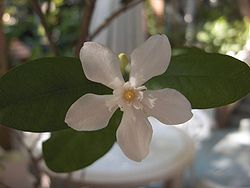- Wrightia antidysenterica
-
Wrightia antidysenterica

Clasificación científica Reino: Plantae División: Magnoliophyta Clase: Magnoliopsida Orden: Gentianales Familia: Apocynaceae Subfamilia: Apocynoideae Tribu: Malouetieae Género: Wrightia Especie: W. antidysenterica Nombre binomial Wrightia antidysenterica
(L.) R.Br.Wrightia antidysenterica es una especie de arbusto perteneciente a la familia Apocynaceae.
Contenido
Distribución y hábitat
Es nativa de las regiones tropicales de Asia, en especial de las zonas boscosas y secas de India, Birmania, Tailandia, Vietnam y Malasia.[1]
Descripción
Es un arbusto que alcanza los 15 metros de altura. Tiene la corteza gris y esponjosa con gran cantidad de latex. Las hojas son de 8–12 cm de longitud y 4–6 cm de ancho, son opuestas, ovales-lanceoladas y acuminadas con una gran cantidad de venillas en su envés. Las flores son de color blanca y se encuentran agrupadas en cimas terminales o axilares, tienen cinco pétalos y cinco sépalos. Son muy aromáticas. Los frutos son folículos dobles, largos y estrechos que tienen 40–50 cm de longitud y solo 1.5 cm de ancho. Las semillas son planas con pelillos sedosos.
Propiedades
- Se utiliza contra la diarrea y disentería amebiana.
- Es antihelmíntico en especial contra los oxiuros.
- Empleado contra las infecciones vaginales por tricomonas.
Sinónimos
- Nerium antidysentericum L., Sp. Pl.: 209 (1753).
- Echites antidysentericus (L.) Roxb. ex Fleming, Asiat. Res. 11: 166 (1810).
- Holarrhena antidysenterica (L.) Wall., Numer. List: 1672 (1829).
- Walidda antidysenterica (L.) Pichon, Mém. Mus. Natl. Hist. Nat., B, Bot. 1: 74 (1951).
- Nerium zeylanicum L., Cent. Pl. II: 12 (1756).
- Nerium divaricatum Lour., Fl. Cochinch.: 142 (1790), nom. illeg.
- Wrightia zeylanica (L.) R.Br., Asclepiadeae: 59 (1810).[1]
Referencias
- ↑ a b «Wrightia antidysenterica». Royal Botanic Gardens, Kew: World Checklist of Selected Plant Families. Consultado el 16 de septiembre de 2009.
Enlaces externos
 Wikimedia Commons alberga contenido multimedia sobre Wrightia antidysenterica. Commons
Wikimedia Commons alberga contenido multimedia sobre Wrightia antidysenterica. Commons Wikiespecies tiene un artículo sobre Wrightia antidysenterica. Wikispecies
Wikiespecies tiene un artículo sobre Wrightia antidysenterica. Wikispecies- Imágenes en Google
Bibliografía
- Govaerts, R. (2003). World Checklist of Selected Plant Families Database in ACCESS: 1-216203. The Board of Trustees of the Royal Botanic Gardens, Kew.
- On the Asclepiadeae. A Natural Order of Plants Separated from the Apocineae of Jussieu. London 63. 1810 (Mem. Wern. Nat. Hist. Soc. 1:74. 1811)
- USDA, ARS, National Genetic Resources Program. Germplasm Resources Information Network - (GRIN) [Data from 07-Oct-06]. [1]
Categorías:- Wrightia
- Plantas medicinales
- Flora de India
- Flora de Birmania
- Flora de Tailandia
- Flora de Vietnam
- Flora de Malasia
Wikimedia foundation. 2010.
